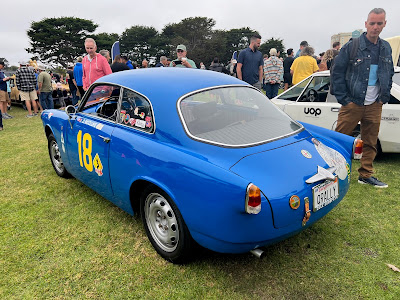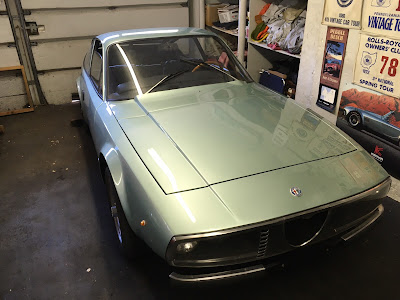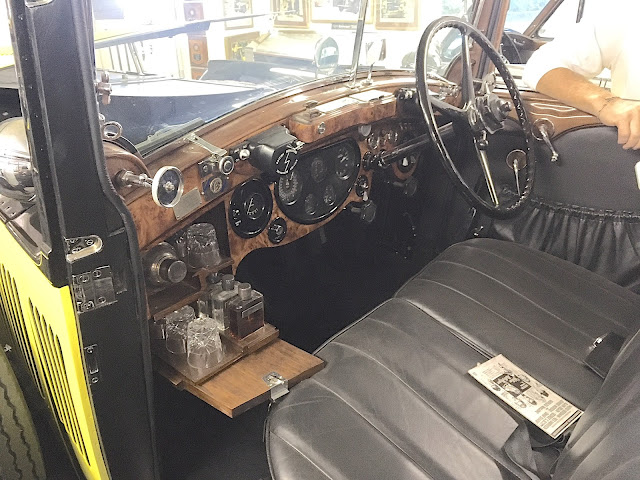The originators of the Concours d'LeMons, held on the second Saturday morning of Monterey Car Week, had the bright idea of holding an event showcasing the least-celebrated cars, hapless vehicles generally known as lemons…
There's also a 24 Hours of LeMons, described by the organizers as "wheel to wheel racing for $500 cars". That event did not occur on our weekend, but the Upside Down Car shown was a former participant. Described as a Ford / Chevy, the Upside Down is a 1990 Chevy Camaro body mounted to (or really under) a 1990 Ford Festiva chassis. Built by an outfit called Speedy Cop, the combined price including both cars was within the $500 limit. In a way, the Upside Down Car is a perfect metaphor for the Concours d'LeMons, which gives awards for Worst Car in various categories, and provides a counterpoint to the Pebble Beach Concours, for which exhibitors fly in on private jets to look at their cars on what is known as The Lawn.
This Stepdown Hudson from 1950 accentuates its hunkered-down styling with a deftly chopped top and some updated wheels. We thought that, like the Hudson Hornet that appeared in 1952, it qualified as a Pretty Good Car, and hope it didn't win a Worst Car award.
Parked next to the Hudson is another car originally conceived as a sort of Hail Mary pass to save an independent car maker, the Studebaker Avanti. We've always had a soft spot for it. The aerodynamic styling from Loewy Associates would keep it on our list of Pretty Good Cars, even if it didn't have the built-in rollover protection, the front disc brakes, and the supercharging option.
 The Nash Metropolitan offered American styling in a two-seater with British (Austin) power from 1953 to 1961. Assembled by BMC initially 1.2 liters (42 hp, about like a Beetle), the 85" wheelbase mini Nash received a 1.5 liter four with 10 more hp halfway through the 1956 model year. That, along with the "Z" trim and trunk lid added the same year, makes this Metro a Series 56, and more a candidate for Cutest Car than Lowliest Lemon. But we'd consider the heavy red Bricklin two-seater parked alongside for some kind of Worst award. Maybe Worst Car With Gullwing Doors...
The Nash Metropolitan offered American styling in a two-seater with British (Austin) power from 1953 to 1961. Assembled by BMC initially 1.2 liters (42 hp, about like a Beetle), the 85" wheelbase mini Nash received a 1.5 liter four with 10 more hp halfway through the 1956 model year. That, along with the "Z" trim and trunk lid added the same year, makes this Metro a Series 56, and more a candidate for Cutest Car than Lowliest Lemon. But we'd consider the heavy red Bricklin two-seater parked alongside for some kind of Worst award. Maybe Worst Car With Gullwing Doors...The BMW 502 was known as the Baroque Angel in Germany because of its slightly frumpy, bulbous form. We'd always liked the 2.6 liter sedan for the lightweight V8 that powered the 503 and 507 in 3.2 liter form, and for those friendly-looking lines. The forlorn condition of this 1960 example, along with the stuffed weasel in the back seat, may have lined it up for an award...
The Rueful Britannia section welcomed three fiberglass-bodied Brits, including the Honda motorcycle-engined Berkeley roadster in the foreground, the Mini Marcos built with BMC Mini drivetrains from 1965 to '70 by the firm that originally built the slinky, plywood-chassis Marcos GT coupe, and a Reliant 3-wheeler designed to take advantage of lower taxes applied to that category...
The Unmitigated Gaul section featured a Renault 16, the pioneering Sixties front-driver from the French firm, a Peugeot 505 from the a couple decades later, a twin-cylinder Citroen Dyane bread van, and a classic Citroen Deux Chevaux. We thought a Peugeot diesel, rather than this gas model, might have qualified for some kind of Worst Award, and that the Citroens, though slow, were known as reliable example of minimalist transport. The Renault 16 has a different wheelbase on the driver and passenger sides, owing to the rear suspension design. Somehow, we just had to tell you that...
Virgil Exner's design for the 1962 Dodge Dart* was almost as unloved as his reverse-fin design for the '61 Dart, and performed like a clunker in the showroom, though the slimmed-down '62 featured power choices ranging from the bulletproof Slant Six to the lusty 413 V8, in Unibody cars that weighed less than competing Fords and Chevies. Because of that styling, though, the Dart was a contender for an award.
Across from the Dodge Dart* on the grass was another car originally called a Dart by its maker, Britain's Daimler. After being warned by Chrysler Corp. that it owned the name, Daimler selected SP250 for its fiberglass-bodied roadster featuring a modern 2.5 liter V8 in a chassis borrowed from Triumph's TR3. Fittingly, this pristine example is parked next to one of those. The SP250 was a better car than its styling would indicate; that exterior won it the Ugliest Car award at the 1959 New York Auto Show, and made it a contender at the Concours d'LeMons.
One aspect worth mentioning about the LeMons event was the high percentage (nearly 100%) of cars that were driven to it under their own power. Below, a view of the Mini Marcos and the Reliant 3-wheeler tooling down Highway One...
The general reliability of Japanese cars, along with their frequently bland styling, meant there were few major award contenders from the island nation. This Nissan Leaf electric, however, made up in sheer improbability what it may have lacked in out-of-the-box potential.
The builders decided the Leaf needed more power, and mounted a Kawasaki motorcycle engine behind the cabin and above the rear wheels. We're not sure about how this coordinates with the Leaf's front-drive electric power, or how it affects polar moments etc., but we liked the casualness of the rear-window scoop feeding air to the rear-mounted radiator. And we liked the cheekiness of the whole idea.
In a similar burst of good-humored innovation, the builders of this VW Short Van simply lopped off what they didn't need, and welded the rest together...
Cars with bad styling when showroom fresh had a head start at the LeMons. This '75 Lincoln amplified its award potential with fur (or faux horsehair) covered coachwork, and a raging stallion emerging from the roof. A serious contender, we thought...
Remember the '60 and '61 Comets, with their odd, slanted tail lights? This one is a contender in the Rust-Through Category...
A dozen or so years later, Mercury stylists did with the hapless Pinto (remember those exploding fuel tank lawsuits) something like their trick of stretching the Falcon into the Comet. Though here it involved less tooling cost, just a traditional grille and some plastic simulated wood siding. We'd forgotten the Bobcat, and there were two examples here to make us remember. We remain unsure if that's a good thing...
After the relatively clean AMC Javelin of 1968-'70, Richard Teague's design department decided to spruce up the car with bulbous fenders and excessive front overhang. Not a good idea, but a natural contender at the LeMons...
Back in the late Fifties, Kellison was one of a raft of outfits making fiberglass bodies for your MG or Triumph or what-have-you SCCA racer project. This one was too nicely finished to be a contender at the LeMons...
Two LeMons judges drove to the event in this gem of Alfa Giulietta coupe and the shiny, fashionably gray 911 alongside it. That cardboard sign on the Alfa reads, "Relax; we're judges."
Perhaps it was a sign that the Concours d'LeMons had done its job, when a couple of attendees who brought clean, shiny collectible cars felt the need to apologize...
*Footnote:
We took a close look at the design of the Daimler Dart / SP250 in "Worst Car Designs Ever: Part One, A Tale of Two Darts", posted July 28, 2016. That post also examined a couple of Dodge Darts designed by Virgil Exner, but not the 1962 example that showed up at the Concours d'Lemons. So many cars; so little time...
Photo Credits:
All photos were taken by George Havelka except the following, which were taken by the author: Top, 4th & 5th, 7th, 9th & 10th, 12th.



















































